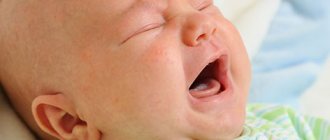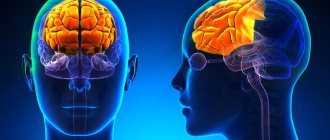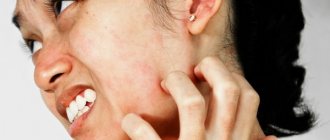Article:
In early childhood, neuropsychiatric disorders such as tics are quite common.
The scientific name is tic hyperkinesis. Parents immediately notice changes in the baby’s behavior. Uncontrolled movements of certain parts of the body or certain muscles in a child cannot but become a cause for concern and questions arise:
- Where did the disease come from?
- Could it have been prevented?
- What to do?
- How to treat?
This list can go on for a long time. One thing is clear - there is certainly cause for concern. And the first thing you need to do is find out as much information as possible about this neurological disorder.
So what are nervous tics in children and what is their danger?
GENERAL CONCEPT OF TIKS
This is the most popular pathology of the children's nervous system at an early age. It is simply impossible not to visually notice the manifestation of a tic, although some parents manage to go for weeks or even months without seeing any oddities in their child’s behavior.
Tics are involuntary, stereotypically repetitive, sudden or jerky movements that are the result of spontaneous contraction of individual muscles or groups of muscles.
At the initial stage of development of the disorder, attacks occur quite rarely, and repetitive movements do not cause much concern or problems. The child can even restrain or control them. However, attempts to control the tic cause him:
- internal discomfort;
- feeling of anxiety;
- mental stress.
When control over oneself weakens, tic manifestations occur, and the baby immediately receives obvious relief.
Nervous tics in children are usually detected between the ages of two and fifteen years. In the period of 6–8 years, tic hyperkinesis most often develops, while at 14–15, in approximately half of the cases it disappears spontaneously.
Fun fact: Boys are five times more likely to have the disorder than girls. From a scientific point of view, this is explained by the more stable psyche of female representatives.
VARIETIES OF NERVOUS TICS IN CHILDREN
Each child has his own individuality, and therefore nervous tics that arise for one reason or another are different.
Tic manifestations generally have two types:
- Motor (motor). They are detected by spasms of individual muscles, their groups or movement of limbs and other parts of the body.
- Voice (vocal). They can be recognized in the form of frequently repeated individual sounds, syllables, exclamations, words and even phrases.
Both groups are divided into simple and complex tics. Everything is clear here. A simple form - one short movement or sound, a complex one - several muscle groups are involved, if there are vocal disorders, progress is also observed in them.
First aid
If a vocal tic suddenly appears, it is worth using some techniques to help eliminate its symptoms. The most effective way is distraction - an interesting and exciting activity that can captivate a child.
It is very important to find something your child likes: such a distraction will help him forget about tics, at least for a while.
Any activity is suitable, except watching TV and computer games. It is better to give preference to board and outdoor games, drawing, and building construction sets. Girls can be offered handicrafts - embroidery, beading, sewing, etc.
Passion for an interesting activity creates active areas in the child’s brain that drown out pathological impulses. Signals from the extrapyramidal zone no longer emanate, and the tic disappears. However, this method gives only a temporary effect: when the child finishes doing what he was interested in, the tic will resume.
MAIN MANIFESTATIONS
Localization of tic movements most often occurs in the facial or neck muscles. Over time, they can spread from top to bottom. The most common examples of simple childhood motor tics are:
- frowning;
- blinking;
- squinting;
- moving the wings of the nose;
- drawing in air through the nose;
- twitching of the corner of the mouth;
- turning or tilting the head;
- shrug;
- flinching;
- twitching of limbs;
- flexion or extension of fingers;
- snapping fingers.
Vocal tics are manifested by coughing, throat sounds, sniffling, spoken syllables or exclamations. This is a meaningless sound that interferes with speech and gives the impression of stuttering or stuttering. If no measures are taken to eliminate them, the situation will only get worse. Tic movements also progress and reach a new level in the form of:
- grimace;
- head tossing;
- touching various parts of the body with hands;
- contractions of the abdominal muscles or diaphragm;
- squats;
- bouncing.
All of the above nervous tics in children are not all manifestations of the disease. They can be individual and atypical. It all depends on the child’s level of development, his character and temperament, sensitivity to environmental stimuli and a number of other reasons.
Symptoms of hyperkinesis
In principle, it is more than obvious.
Although each type of this disease has its own specific symptoms. However, there are also general symptoms: - voluntary movements of the arms, legs or other parts of the body; - during walking, other movement, emotional or nervous tension, the manifestations of pathology intensify; - pronounced trembling of the body or its parts; - there is a possibility of reducing the intensity or completely stopping the attack through pain, changing posture; - absence of seizures, tics and tremors during rest (sleep).
If hyperkinesis is diagnosed, symptoms will help determine its type and prescribe appropriate therapy.
FEATURES OF THE DISEASE
Initially, the child exhibits motor tics, and if the situation worsens, then vocal tics join them. However, there are cases when hyperkinesis begins with sound tics, which significantly complicates diagnosis and delays treatment.
In severe cases, several types of spontaneous movements are observed simultaneously. Sometimes they are accompanied by vocal tics.
Nervous tics in children have their own characteristic features, which make it possible to distinguish them from other pathologies of motor functions. They can be divided into several points:
- Self-control. It should be noted that it works only in the early stages of the disease. This means that the child can control his seizures, but over time it becomes more and more difficult to do so.
- Increased symptoms due to stressful situations. The same tendency is observed at the end of the day due to overwork of the nervous system. The autumn-winter period is the peak of the disease.
- The child's consciousness is not affected in any way. This fact allows us to exclude the development of epilepsy.
- Hyperkinesis does not occur during sleep. This feature is relevant in the presence of vocal tics and confirms the absence of pathologies of the upper respiratory tract.
- A nervous eye tic in a child can at first be mistaken for developing conjunctivitis, but soon everything becomes clear.
The following pattern has been noticed: the earlier the disease appears in a child, the more severe it will be. If appropriate measures are not taken, hyperkinesis develops into a chronic form. In this case, treatment is complicated by the fact that several muscle groups may gradually be involved. Pathological movements move from the head to the lower organs and become more complex, vocal tics are added. Doctors assess them as generalized.
Tic manifestations that arise after the age of ten are almost always classified as transient. This means that they disappear spontaneously and unnoticed, just as they appeared. They are also called transient. They do not require special participation from the medical side.
REASONS FOR THE APPEARANCE
Despite countless years of research into nervous tics in children, doctors have not been able to come to a common point of view regarding the provoking factors. But among many theories, it was found that the most likely are the consequences of traumatic influences. These include:
- Fright.
- Fear.
- Divorce of parents or forced separation from one of them.
- Change of environment.
- First of September. The first days of school are extremely stressful for a child.
- The birth of a second child in the family.
Heredity also plays an important role in the occurrence of tics. Children whose parents experienced hyperkinesis in childhood are much more likely to develop it too.
An unstable situation in the family or immediate environment that a child encounters in kindergarten, school, or in the yard is, of course, the main provoking factor. Children's relationships, communication with peers and adults, can be of a very diverse nature. They often contain conflict situations, and they serve as the starting point of nervous disorders.
Organic brain damage can also cause nervous tics in children. Sometimes they are a consequence of the following events:
- severe maternal pregnancy and difficult childbirth;
- traumatic brain injury;
- a previous neuroinfectious disease.
Separately, it should be mentioned that the reasons for the development of tics may be hidden in a lack of any vitamins, minerals or trace elements. Since the child’s body is just being formed and is very unstable to external influences, hypovitaminosis can cause disturbances or malfunctions of the nervous system.
It has been noticed that the disease progresses in waves. If the child is in a calm, balanced mental state, then tic movements may decrease to minimal manifestations or not be observed at all. At the same time, any stressful situation, fear or anxiety, serves as an impetus for exacerbation of the condition and intensification of tics.
Characteristics of the pathology
It should be noted that hyperkinesis is twitching not only of the arms and legs, but also of the shoulders, eyelids, facial muscles and the whole body as a whole. The peculiarity of the disease is that it can significantly limit a person’s movement, disrupt his gait, and make self-care impossible. Spontaneous movements are usually unnatural. The disease can be congenital or acquired. The lesion is the thalamus, cerebellum, and midbrain. Movements may also occur due to poor communication between the cortex and subcortex of the brain. It should be noted that the manifestations of pathology intensify with an emotional outburst, while in sleep the intensity of movements is inhibited. And the symptoms of the disease do not depend on the location of the process. That is, even if the same area of the brain is affected, the symptoms may be different. As for the severity of the pathology, it depends on how extensive the affected area is.
DIAGNOSTIC PROCEDURES
Before starting any treatment, you need to have your child examined by a specialist. After the initial examination, the neurologist refers the patient to undergo electroencephalography. It makes it possible to identify the following indicators:
- local cerebral disorders;
- foci of pathological activity;
- analysis of the state of brain activity.
Repeated studies allow you to monitor the effectiveness of the therapy. A biochemical blood test is mandatory. If the doctor deems it necessary, the child may be sent for an MRI.
Identifying nervous tics in young children, establishing their causes and prescribing adequate treatment is the task of a neurologist. But the direct responsibility of parents is to ensure a comfortable stay for the child at home, in an educational institution or on the street. It is necessary to find out the factors that pose a threat to the baby’s psyche and eliminate them in any way.
Diagnostics
Diagnosis and treatment of vocal tics is carried out by a pediatric neurologist. You should plan a visit to him if the tick:
- strongly expressed;
- causes physical discomfort to the child;
- interferes with comfortable communication, disrupts social adaptation;
- combined with involuntary blinking, unnatural facial expressions, twitching of the limbs and head;
- does not go away within 30 days.
After an examination and a detailed interview with the young patient and his parents, the doctor may prescribe a general blood test to rule out infections, including parasitic ones; analysis directly for the presence of helminths; analysis for microelements - ionogram.
If a traumatic brain injury or disease is suspected, an MRI (magnetic resonance imaging) scan is performed. An electroencephalogram is necessary to identify and record in writing increased activity in different parts of the brain.
A primary vocal tic that occurs as a result of prolonged shock or an acute traumatic situation is an indication for consultation with a psychotherapist. An infectious disease specialist is involved in treatment when an infection is detected in the body.
In case of poisoning by poisons or drugs, detoxification therapy is carried out by a toxicologist. Children with diagnosed brain tumors are treated by an oncologist.
TREATMENT
Very often, children who are diagnosed with tic hyperkinesis do not need special therapy. It is absolutely meaningless, and only correction of the patient’s lifestyle helps. However, if the tics become generalized, then treatment cannot be avoided. But which method the doctor chooses depends on the severity of the disease, age and physical characteristics of the child.
An integrated approach to treating tics in children is possible. It includes:
- Activities aimed at properly organizing the child’s daily routine. Protecting him from stress, anxiety and other troubles.
- Drug-free therapy. This complex includes a visit to a psychotherapist, physiotherapeutic procedures, and reflexology.
- Treatment with medications.
At the initial stages of the development of tics in young children, only routine measures are sufficient for visible positive dynamics. Rationally organized time for activities and rest, timely going to bed, proper nutrition, and exercise are the key to a positive outcome from a nervous disorder.
Family psychotherapy is of no small importance. If the situation in the family has given impetus to the development of tics, then you need to try to correct it. Under no circumstances should the child witness quarrels or scandals. It is necessary to create a calm, trusting environment so that the child feels loved and protected. You should not pull back or remind him of his nervous disorder, as this will only aggravate the situation.
Good results in the prevention and treatment of tics are provided by educational games using fine motor skills, art therapy, and relaxation. The most commonly used physiotherapeutic methods to combat this disorder are:
- biofeedback method;
- audiovisual stimulation method;
- acupuncture;
- laser therapy;
- ozokerite applications;
- massage of the cervical-collar area;
- electrosleep.
In cases where drug treatment cannot be avoided, sedatives are first prescribed. They have a general calming effect, remove nervousness and irritability. If the expected effect is not observed, the doctor prescribes tranquilizers. Their scope of action is the relief of emotional stress, anxiety and fears.
With progressive tic hyperkinesis, which is not amenable to gentle treatment, more severe drugs are used. These include antipsychotics and antidepressants. Unfortunately, these medications have a lot of side effects and are used only as a last resort, only as prescribed by a doctor and strictly following the dosage. The main indicator for use is the safety of the child, taking into account the special sensitivity of the not yet formed organism, including the nervous system.
Treatment of tics in children is usually carried out on an outpatient basis, since hospitalization can be an additional source of anxiety. For the same reason, drug therapy is avoided by injection.
POSSIBLE CONSEQUENCES
Nervous tics in children of different ages, regardless of the cause, are signals that not everything is all right with the child, his mental state is at the limit of his capabilities, and he needs immediate help. If the irritant is removed in time, the tic manifestations go away spontaneously.
What happens if you leave everything as is? There are several possible scenarios here:
- Epilepsy. Tics may be symptoms of the early stages of this severe neurological disease.
- Severe neuroses, psycho-emotional disorders. Untreated hyperkinesis progresses in the child’s body, causing new manifestations of the tic condition. Lack of qualified help leads to the development of depression and other critical conditions.
- Tourette's syndrome. Although this mental disorder is not a consequence of parental inactivity, its clinical picture necessarily includes both motor and vocal tics.
Even if hyperkinesis disappears on its own after a week without any consequences, it is necessary to go to the doctor and undergo diagnostic procedures. This is a guarantee of the child’s health, and is done with the aim of eliminating the above diseases.
ADAPTATION IN SOCIETY
Children, as we know, are cruel by nature, so it will be very problematic for a child with obvious manifestations of hyperkinesis to adapt to a new team. But it’s not his fault that the nervous tic happened to him. When communicating with adults, it is very important for him to feel a tolerant attitude. And if at home they constantly focus attention on this topic and reprimand the child, believing that he is doing this on purpose, the situation only gets worse.
Parents should be completely on the side of the child, and he should feel this not only in words. This is what it should look like:
- all conversations about nervous disorders, including tics, should be prohibited, especially in the presence of a baby.
- do not focus on the problem, behave freely and naturally.
- conduct an explanatory conversation with teachers or educators of the team that the child attends, and call on them for assistance.
- choose a suitable leisure activity for your child. Single active sports, such as skiing or swimming, are encouraged.
- provide nutritious and varied nutrition.
During adolescence, a teenager’s body is unpredictable, and also undergoes hormonal changes. If at this stage nervous tics are also detected, then this can generally turn into a personal tragedy. First of all, self-esteem suffers; the child withdraws into himself, does not want to communicate with anyone, and is fixated only on his illness.
The parents’ task is to consider the threat in time and take all measures to eliminate it. Even if the tics do not go away on their own, there is every chance that properly selected therapy or medication will help get rid of them. In any case, you can and should strive to live a full life.
Feedback from parents on the topic: “How to reduce vocalization in a child with ASD”
| Positive | Negative |
| My son uttered the same set of sounds for days: “ayayayy” with a monotonous intonation. It was driving me crazy. We started attending individual sessions with a speech therapist three times a week. We all were patient and followed all the instructions at home. And after a month we noticed that the number of vocalizations had decreased. We’ve been doing this for six months now, and we’ve practically forgotten about this behavioral feature. It is important not to let the child’s condition take its course. (Leah) | Whenever I look at it, everyone is so fixated on this, well, the child is “humming” something under his breath, let him. Doesn't scream, doesn't harm himself. And if it annoys those around you, then it’s their nerves that need to be treated! Autistic children need to learn to accept, and not “break” them and adjust them to suit themselves. (Ulyana) |
| In our kindergarten group there was a boy who constantly mumbled something under his breath. At first, his teachers protected him from children and insisted that he be removed from the group. But the defectologist insisted on the opposite and began to actively work with him. When I met this boy in the corridor two months later, he was unrecognizable. He even said hello to me. And the daughter said that she even plays with him, and he no longer makes any extraneous or annoying sounds. The main thing is to find the right specialist, and everything can be solved! (Nastya) | Autistic people are special, they are like aliens on our planet, and they need vocalization to calm themselves down, tune in to learning something new, etc. Why deprive them of this method? Learn to simply understand your child. (Olya) |
| Our daughter vocalizes only when she draws; every movement with a pencil or brush is quietly accompanied by a long “oooooh” sound. We didn’t deprive the child of drawing, we just learned to abstract ourselves from the sound and not get irritated. Advice to parents: if the vocalization is not so aggressive, just train yourself to have a sense of self-control. Good luck to everyone and be patient! (Sveta) | We deal with vocalization ourselves, since we haven’t found a competent specialist, and private owners are very expensive. In our country, “everything is for the people,” no one needs our crumbs, so we self-medicate. (Tatiana) |
| I distract my son from stereotypy by bathing and washing his hands (if at home), water very calms and relaxes him, or by turning on his favorite cartoon (we love Smeshariki), fortunately, the tablet with all the episodes is always with me. Find your little one's hobbies and use them wisely. (Ksenia) | In our country, vocalization manifests itself in the form of squealing, this is a reaction to happiness and joy. Good mood = squeal. When bad things happen, he snorts. And you know, all these sounds help me understand my daughter. I don't understand why she should be treated. (Faith) |
| Our psychiatrist approached this issue competently and developed a whole program with stages. We’ve been training for six months now; all that’s left is sound aggression as a manifestation of protest. Soon we will overcome it too. Yes, it takes a lot of time to study, but it's worth it. You won't see results in one day. (Lena) | Unfortunately, not one of the known methods helps us cope with the stereotypical sounds “to nowhere”; there are very inappropriate ones, for example, in line at the doctor (other kids get irritated and begin to cry and become aggressive, I’m already silent about adults). We have to protect our son from society as much as possible. I hope someday we will overcome this problem. (Darina) |
PREVENTION TIPS
To prevent a child’s nervous tics from developing into more serious mental disorders over time, all possible measures must be taken to prevent them. You don't need anything supernatural to do this. It will be enough not to forget that the baby sees the behavior of the parents and people around him, draws his own conclusions and evaluates the events taking place due to his level of development.
The psyche of a child at an early age is unstable and vulnerable, so any clarification of the relationship between parents in a raised voice is a stressful situation that can lead to tic manifestations. It is in the family that the child should feel support and understanding. This is his fortress, in which, if necessary, he can hide from all his fears. If there is no such relationship, then the risk of developing tics is quite high.
Children living in a calm, friendly environment are very rarely susceptible to nervous tics. To avoid having to treat the consequences of mental imbalance in a child, it is enough to create comfortable conditions for him. They are as follows:
- avoidance of anxiety and stressful situations;
- healthy, full sleep;
- high-quality and healthy food, a ban on fast food and overly sweet and fried foods;
- compliance with the daily routine, proper organization of rest;
- dosed computer use and TV viewing;
- maximum exposure to fresh air;
- classes in sports sections that match the interests and temperament of the child;
- inadmissibility of overwork.
In rare cases, raising the younger generation does not involve punishment. They are certainly necessary, but within reason. Physical impact is immediately excluded. Only moral methods of influence are acceptable. The child must clearly know what offense he is being punished for and how he should have done the right thing. At the same time, you should assure the child that punishment does not affect his love for him. Only in such a situation will he draw the right conclusions and receive minimal nervous shock.
Even if the appearance of nervous tics in a child could not be avoided, it should be remembered that this is not the worst thing that could happen to him. Modern medicine, combined with parental care and attention, can work wonders.







